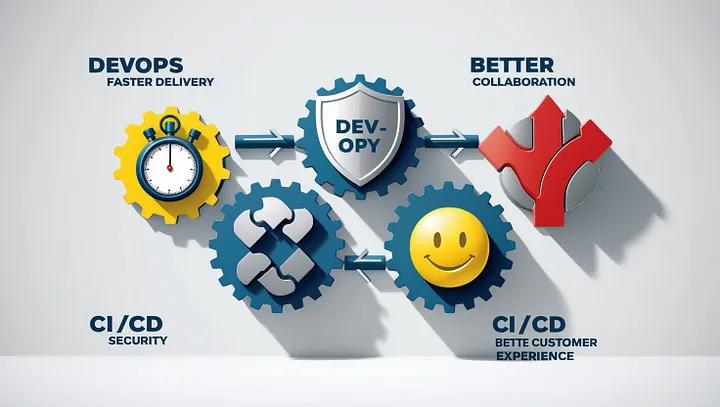What is DevOps?
DevOps is a combination of “Development” and “Operations” and represents a set of practices that aim to automate and integrate the processes between software development and IT operations teams. The main goal of DevOps is to shorten the software development lifecycle, deliver high-quality software continuously, and provide faster and more reliable updates and deployments.
DevOps is not just a set of tools or processes; it’s a culture shift that promotes collaboration, communication, and integration between development and operations teams. It involves automating repetitive tasks, continuously monitoring performance, and creating a feedback loop to quickly identify and resolve issues. This approach helps companies deliver software faster, with fewer errors, and with more stability.
Why is DevOps Important?
In today’s fast-paced digital environment, businesses need to be agile and responsive to market changes. Traditional software development methods, which often involve long development cycles and infrequent releases, can be slow and inefficient. DevOps addresses these issues by promoting a more dynamic and responsive approach to software development and delivery.
Here are some key benefits of adopting DevOps:
- Faster Time to Market: By automating repetitive tasks, such as testing, deployment, and infrastructure management, DevOps enables faster release cycles, allowing businesses to respond to market demands quickly.
- Improved Collaboration: DevOps encourages close collaboration between development, operations, and other stakeholders. This collaboration reduces misunderstandings, accelerates problem-solving, and leads to more efficient workflows.
- Continuous Integration and Continuous Delivery (CI/CD): DevOps emphasizes CI/CD pipelines, where code changes are automatically tested and deployed to production environments. This reduces manual errors and ensures faster, more reliable releases.
- Enhanced Security: By incorporating security practices into the DevOps workflow (DevSecOps), organizations can identify and address security issues early in the development process, reducing vulnerabilities and improving overall security posture.
- Better Customer Experience: Faster release cycles and improved quality of software lead to a better user experience. DevOps enables companies to release new features, fix bugs, and respond to customer feedback quickly.
Key Components of a DevOps Pipeline
A DevOps pipeline is a series of automated processes that facilitate the integration, testing, delivery, and deployment of software. The following are the key components of a typical DevOps pipeline:
- Source Control Management: Managing code changes using version control systems like Git, GitHub, or GitLab, allowing multiple developers to work on the same codebase without conflicts.
- Continuous Integration (CI): Automatically building and testing code changes to detect issues early. Tools like Jenkins, CircleCI, and Travis CI help automate this process.
- Continuous Delivery (CD): Automating the deployment of code changes to production-like environments after successful testing. This can be done using tools like Docker, Kubernetes, and Terraform.
- Configuration Management: Managing and automating the deployment of infrastructure and environments using tools like Ansible, Puppet, and Chef.
- Monitoring and Logging: Continuously monitoring application performance and infrastructure health, and logging any issues or anomalies. Tools like Prometheus, Grafana, and ELK stack are widely used for this purpose.
- Automated Testing: Ensuring that new code changes do not break existing functionality. Automated testing frameworks like Selenium, JUnit, and TestNG help streamline this process.
Challenges of Implementing DevOps
While DevOps offers numerous benefits, it also comes with its own set of challenges:
- Cultural Shift: DevOps requires a cultural shift where development and operations teams work closely together. This can be challenging in organizations where teams are used to working in silos.
- Skill Gaps: Not all team members may be familiar with the tools and practices associated with DevOps. It often requires additional training and upskilling.
- Tool Overload: With the growing number of DevOps tools available, choosing the right ones that fit your organization’s needs can be overwhelming.
- Security Risks: Faster release cycles can sometimes lead to overlooking security vulnerabilities. Incorporating security from the beginning is essential.
How Soultware Can Help You Adopt DevOps Practices
At Soultware, we understand that implementing DevOps practices can be challenging, especially for businesses that are new to the concept. Our team of DevOps experts can help you streamline your development and operations processes by:
- Assessing your current development and operations workflow.
- Identifying the right DevOps tools and practices that align with your business goals.
- Setting up CI/CD pipelines, automated testing, and monitoring systems.
- Providing training and support to ensure a smooth transition to a DevOps culture.
Contact us today to learn how we can help your business adopt DevOps practices to deliver better software, faster, and with greater reliability.
